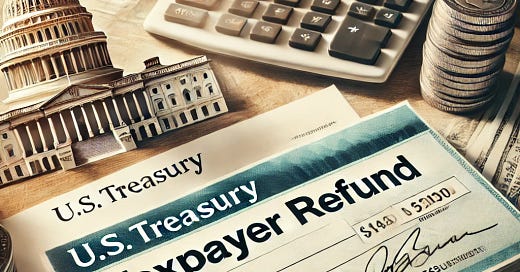Trump’s DOGE Dividend: A $5,000 Check for Taxpayers?
Instead of wasteful spending, what if the government returned savings to taxpayers?
The federal government spends trillions of dollars each year, but how much of that spending actually benefits the average taxpayer? A new proposal suggests that some of the savings from recent cost-cutting measures could be returned directly to working Americans.
Under President Trump’s second term, a cost-reduction initiative called DOGE (Department of Organizational Government Efficiency) has been identifying and eliminating wasteful spending, reportedly saving $1 billion per day.
Now, there’s a proposal to use a portion of those savings to provide tax refunds—known as the DOGE Dividend—to millions of American households.
What Is the ‘DOGE Dividend’?
James Fishback, CEO of Azoria, has outlined a plan to take 20% of DOGE’s total savings and distribute it to tax-paying households as a $5,000 refund check.
Here’s the breakdown:
DOGE is expected to save $2 trillion by mid-2026.
20% of those savings ($400 billion) would be returned to tax-paying households.
That would result in a $5,000 tax refund per household for those who pay federal income taxes.
The idea is to return a portion of identified government savings to taxpayers, rather than allowing those funds to be reallocated elsewhere in the budget.
How This Differs From Past Stimulus Programs
Unlike previous economic stimulus efforts, which were often funded by increasing the national debt, the DOGE Dividend would be paid for entirely through spending cuts. That means:
✅ No increase in national debt
✅ No new money printing
✅ Only tax-paying households receive the benefit
Rather than being an expansion of government spending, this proposal frames the dividend as a refund for taxpayers.
Potential Benefits of the DOGE Dividend
1️⃣ Accountability in Government Spending
Many Americans feel that government spending has lacked transparency and efficiency. Programs like DOGE aim to identify and reduce unnecessary expenditures, and the DOGE Dividend would provide a way to directly share those savings with taxpayers.
2️⃣ Encouraging Workforce Participation
The dividend would only be available to those who are net payers of federal income tax in 2025. This could create an incentive for increased workforce participation, particularly among those on the margin of employment.
3️⃣ Strengthening Public Trust
Studies have shown that public confidence in government spending impacts tax morale—people’s willingness to comply with tax laws. Returning a portion of identified savings could be seen as a step toward restoring trust in government accountability.
4️⃣ No Inflationary Impact
Because the funds would come from actual savings rather than newly created money, the plan is designed to avoid contributing to inflation. Unlike deficit-financed stimulus checks, this dividend would be paid for within the existing budget framework.
Would This Be Feasible?
The biggest challenge would be ensuring that identified savings actually materialize and that Congress agrees to return a portion of those funds rather than redirecting them elsewhere.
There is also the question of whether tax refunds should be prioritized over other fiscal policies, such as debt reduction or reinvestment into domestic programs. However, the DOGE Dividend presents a unique approach to addressing concerns about government waste while offering a tangible benefit to taxpayers.
Next Steps
For the DOGE Dividend to happen, it would require legislative approval and a continued commitment to cutting inefficient spending. Whether or not Congress moves forward with this idea will likely depend on public and political support.
Would returning a portion of government savings directly to taxpayers be a responsible approach to fiscal policy? Let me know your thoughts.




The money just goes back into the US economy. It will have the same effect as the stimulus checks.
At the end of the day, the thing that will make or break this is having more money in our pockets and our dollar going further.